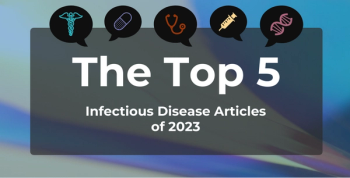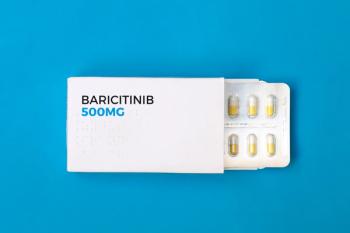
This year’s most-read articles on chronic obstructive pulmonary disease (COPD) explored a variety of topics concerning patients with COPD, including long-acting inhaler adherence and their risk of falling.

Brooke is an associate editor for The American Journal of Managed Care® (AJMC®). She joined AJMC in 2023, where she produces content covering multiple disease states.
She has a BA in journalism from Seton Hall University. You can connect with Brooke on LinkedIn.

This year’s most-read articles on chronic obstructive pulmonary disease (COPD) explored a variety of topics concerning patients with COPD, including long-acting inhaler adherence and their risk of falling.

The researchers noted the need for strategies to better support women living with HIV with breast cancer during toxic therapies to improve outcomes among this growing population.

This year’s most-read articles on infectious disease explored topics like vitamin D deficiency, COVID-19 masking, and Clostridioides difficile infection.

Clostridioides difficile risk is significantly higher in Korean patients with inflammatory bowel disease (IBD), which is comparable to the trend observed in Western patients with IBD.

This year’s most-read respiratory articles explored a variety of topics, including the effects of marijuana and vaping on the lungs.

Increased pulmonary arterial hypertension (PAH) awareness and earlier screening in routine clinical practice could provide an opportunity for earlier treatment, resulting in reduced economic burden for payers, employers, and society at large.


These findings suggest that addressing socioeconomic disparities and inequities that impact access to health care and services may help improve survival outcomes across racial/ethnic groups of male patients with early breast cancer.

The researchers explained that future studies should explore how the physical, emotional, and social impact of hepatitis B on patients could be measured and incorporated into clinical management.

Robert Groves, MD, of Banner | Aetna discusses the challenges primary care practitioners (PCPs) face when addressing social determinants of health (SDOH).

From 2013 to 2022, the all-cause mortality rate among patients with HIV in China declined from 5.4% to 2.7%.

Elaine Siegfried, MD, of Saint Louis University School of Medicine discusses the use of biologics to treat atopic dermatitis (AD) and how they differ from other treatments.

The Biden administration proposed new efforts that it says will promote competition, transparency, and affordability in the health care industry.

Chronic obstructive pulmonary disease (COPD) is associated with fatal events in the long-term prognosis of stroke, but the association between COPD and short-term death in patients with stroke is insignificant.

Although direct-mail self-sampling significantly increased cervical cancer screening, the opt-in approach only minimally increased screening.

The researchers suggested prioritizing and optimizing HIV and general health services for children younger than age 5 living with HIV and receiving ART to help address their disproportionately poorer outcomes.

Based on the Likert scale, most patients with atopic dermatitis (AD) using baricitinib reported being either “satisfied” (76%) or “very satisfied” (18%).

The mean projection of patients' emotions and dyspnea was more optimistic than what was eventually observed.

Raj Chovatiya, MD, PhD, assistant professor of dermatology at Northwestern University's Feinberg School of Medicine, discussed type 2 inflammation in atopic dermatitis, prurigo nodularis, and chronic spontaneous urticaria.

Researchers explained that developing preventative strategies and improving air quality to reduce the concentrations of air pollutants can help to reduce the hospitalizations of patients with chronic obstructive pulmonary disease (COPD).

Based on Behavioral Risk Factor Surveillance System data, about 6.4% of US adults in 2011 (14.3 million people) and about 6.5% (14.2 million) had COPD in 2021, showing that COPD prevalence did not significantly change throughout the decade.

These new atopic dermatitis (AD) treatment guidelines from the American Academy of Dermatology (AAD) update their 2014 recommendations for the management of AD with phototherapy and systemic therapies.

Dr. Parth Rali, MD, of Temple University Hospital explained the challenges of managing patients with intermediate-risk pulmonary embolism (PE) and how risk stratification tools can help to address these challenges.

Researchers hypothesized that health care personnel (HCP) influenza vaccination coverage decreased during the pandemic because individuals may have believed that it was less important than in previous years.

Christian John Lillis, cofounder and executive director of the Peggy Lillis Foundation for C difficile Education & Advocacy, explained how FDA-approved microbiome-based therapeutics help to treat and prevent C difficile infection.

Kimberly Maxfield, PhD, of the FDA discussed actions been taken by the FDA since President Biden's reauthorization of the Biosimilar User Fee Act (BsUFA) III last year, as well as what they plan to achieve through 2027.

To combat C difficile, Christian John Lillis, cofounder and executive director of the Peggy Lillis Foundation for C. Diff Education & Advocacy, noted that awareness and innovation must continue to increase.

With the recent development of various new treatments, April Armstrong, MD, MPH, discusses the new standards she and other dermatologists hope to set for treating patients with atopic dermatitis (AD).

Compared with those without chronic obstructive pulmonary disease (COPD), patients with both sepsis and COPD had higher intensive care unit (ICU) mortality rates, longer ICU stays, and higher in-hospital mortality rates.

Amid National C. Diff Awareness Month, Christian John Lillis, cofounder and executive director of the Peggy Lillis Foundation for C. Diff Education & Advocacy, explains the foundation's "See C. diff" campaign and what the PLF hopes the public will learn throughout the month.

259 Prospect Plains Rd, Bldg H
Cranbury, NJ 08512
© 2025 MJH Life Sciences®
All rights reserved.
